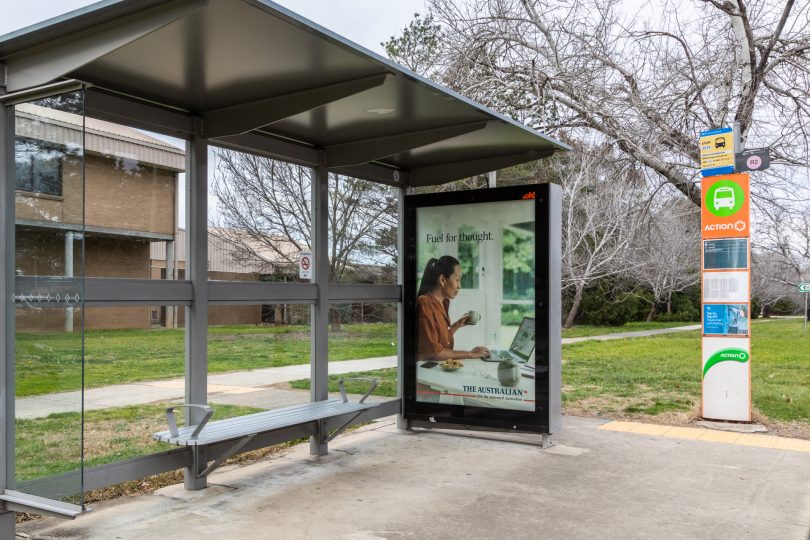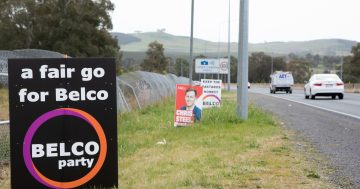
Advertisements are allowed at Canberra bus shelters. Photo: Michelle Kroll.
The ACT’s long-held ban on public advertising is under threat, according to activists who say “illegal ads” are proliferating across the city on bus shelters and vehicles.
Billboards have been banned in the ACT since the 1930s, although they can be approved on the sides of private buildings and private land through the development application process.
There have been multiple debates on the issue, most recently in 2016 when Chief Minister Andrew Barr suggested that a limited amount of digital display advertising might mitigate the proliferation of billboards on vehicles, including trucks and trailers.
Canberra’s ACTION buses can be fully wrapped in advertising and are highly sought after for their visibility while ads can also be placed on Canberra’s bus shelters due to an exception in the National Capital Plan.
It’s these loopholes that the Greens candidate for the seat of Canberra, Tim Hollo, wants closed.
He’s petitioning the ACT Government to remove advertising materials that block windows on buses and trams and introduce a specific offence for roadside advertising that used parked vehicles, describing it as “a socially, economically and environmentally destructive, and fundamentally undemocratic, practice”.
“It is also hugely unpopular in the ACT, having been the subject of sustained community campaigning to protect our relatively ad-free status,” he said.
The Greens have also been behind the proposed ban on election corflutes following last year’s election. That move was strongly opposed by other parties, including the Canberra Liberals and the Belco Party, who said they were an important way to build recognition, especially for lesser-known candidates.
But partner and director of marketing agency Coordinate, Warran Apps, told Region Media that the ACT already had the strictest outdoor advertising requirements in Australia, and while the current framework should be reviewed, the petition’s “ban-all” approach was extreme.
“We would be calling for a more nuanced debate and a reasonable set of evidence-based regulations that recognise the need to prevent a proliferation of outdoor advertising against the reality of the more urbanised city we now live in,” he said.
“Experiences around the world, especially in places like Washington DC, demonstrate that well-regulated outdoor advertising in appropriate locations has a role to play in creating a more active and visually interesting built environment.
“It also provides smaller, local businesses with an important mechanism for local area promotion.”
‘Sign creep’ was identified as an issue in a 2017 ACT Legislative Assembly Committee review of the Territory’s billboard laws. The enquiry attracted a record 166 submissions, most of them strongly opposed to any changes.
The review subsequently recommended creating clear and accessible reporting avenues where the public could lodge complaints about signage in the ACT.
Following the Committee’s report, the government said it would review the complexities of the legal framework in 2018, but Planning Minister Mick Gentleman noted there was “no appetite from the community for Canberra to become Times Square”.




















